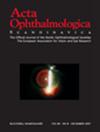Identification of clinical protein markers correlated to the impairment of the lacrimal and meibomian glands in the progression of dry eye syndrome
Abstract
Aims/Purpose: Dry eye syndrome (DES) is a multifactorial pathology of the ocular surface, characterized by disruption of tear film homeostasis. Although prevalent, distinct clinical biomarkers associated with the impairment of the lacrimal (LG) and meibomian glands (MG) that exacerbate the progression of DES are still largely lacking. This study was conducted to identify potential DES markers for precise clinical diagnosis.
Methods: Subjects underwent a battery of clinical examinations including the basic secretory test via Schirmer I to evaluate the functional impairment of the LG that leads to aqueous-deficient DES (DRYaq). Meanwhile, tear break-up time (TBUT) test was used to evaluate the impairment status of the MG, which leads to evaporative DES (DRYlip). Next, the tear samples (N = 307) were analyzed individually employing mass spectrometry-based proteomics, followed by in-depth statistical and bioinformatics analyses.
Results: A total of 47 proteins, largely secreted by the LG and annotated to antibacterial response (p = 5.0 × 10-9) were found to be significantly (p < 0.01) decreased in abundance with the progression of DRYaq, namely LTF (r = -0.79), PROL1 (r = -0.64) and AZGP1 (r = -0.58). On the contrary, as many as 360 proteins were found to be significantly increased in abundance with the progression of DRYaq, namely SFN (r = +0.68), ORM2 (r = +0.67) and TXN (r = +0.66). These proteins are annotated to various biological functions, especially inflammatory response (p = 3.0 × 10-17), apoptosis (p = 2.1 × 10-29) and synthesis of reactive oxygen species (p = 3.7 × 10-29). Only 26 proteins were found to be significantly expressed with the progression of DRYlip, namely ACTN2 (r = -0.33) and ARG1 (r = +0.48). These proteins are exclusively annotated to anti-inflammatory response (p = 8.1 × 10-5), citrulline biosynthesis (p = 4.5 × 10-3) and IL-15 signaling (p = 2.5 × 10-4).
Conclusions: For the first time, our study analyzed the proteome of the largest number of individual tear samples in a clinical setting. Importantly, we identified progressive changes in the expression of specific protein markers correlated to the functionality of the LG and MG that could be potentially leveraged for future development of improved clinical diagnosis and targeted therapeutic interventions to ameliorate DES in a personalized manner.

 求助内容:
求助内容: 应助结果提醒方式:
应助结果提醒方式:


